
According to Roman tradition, Lucretia, anglicized as Lucrece, was a noblewoman in ancient Rome. Sextus Tarquinius (Tarquin) raped her and her subsequent suicide precipitated a rebellion that overthrew the Roman monarchy and led to the transition of Roman government from a kingdom to a republic. After Tarquin raped Lucretia, flames of dissatisfaction were kindled over the tyrannical methods of Tarquin's father, Lucius Tarquinius Superbus, the last king of Rome. As a result, the prominent families instituted a republic, drove the extensive royal family of Tarquin from Rome, and successfully defended the republic against attempted Etruscan and Latin intervention.
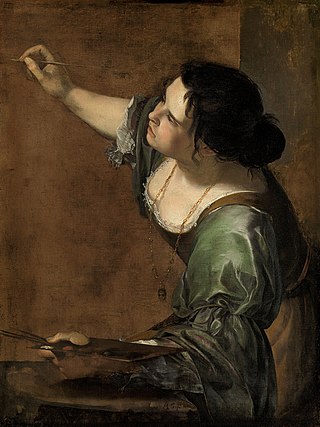
Artemisia Lomi or Artemisia Gentileschi was an Italian Baroque painter. Gentileschi is considered among the most accomplished seventeenth-century artists, initially working in the style of Caravaggio. She was producing professional work by the age of 15. In an era when women had few opportunities to pursue artistic training or work as professional artists, Gentileschi was the first woman to become a member of the Accademia di Arte del Disegno in Florence and she had an international clientele.

Orazio Lomi Gentileschi (1563–1639) was an Italian painter. Born in Tuscany, he began his career in Rome, painting in a Mannerist style, much of his work consisting of painting the figures within the decorative schemes of other artists.

Sextus Tarquinius was one of the sons of the last king of Rome, Lucius Tarquinius Superbus. In the original account of the Tarquin dynasty presented by Fabius Pictor, he is the second son, between Titus and Arruns. However, according to Livy and Dionysius of Halicarnassus, he was either the third or first son, respectively. According to Roman tradition, his rape of Lucretia was the precipitating event in the overthrow of the monarchy and the establishment of the Roman Republic.
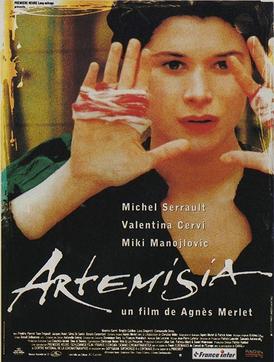
Artemisia is a 1997 French-German-Italian biographical film about Artemisia Gentileschi, the female Italian Baroque painter. The film was directed by Agnès Merlet, and stars Valentina Cervi and Michel Serrault.

Judith Slaying Holofernes is a painting by the Italian early Baroque artist Artemisia Gentileschi, completed in 1612-13 and now at the Museo Capodimonte, Naples, Italy. The picture is considered one of her iconic works. The canvas shows Judith beheading Holofernes. The subject takes an episode from the apocryphal Book of Judith in the Old Testament, which recounts the assassination of the Assyrian general Holofernes by the Israelite heroine Judith. The painting shows the moment when Judith, helped by her maidservant Abra, beheads the general after he has fallen asleep in a drunken stupor. She painted a second version now in the Uffizi, Florence, somewhere between 1613 and 1621.

Spurius Lucretius Tricipitinus is a semi-legendary figure in early Roman history. He was the first Suffect Consul of Rome and was also the father of Lucretia, whose rape by Sextus Tarquinius, followed by her suicide, resulted in the dethronement of King Lucius Tarquinius Superbus, therefore directly precipitating the founding of the Roman Republic. It is believed that Lucretius and his accomplishments are at least partly mythical and most ancient references to him were penned by Livy and Plutarch.

Lucretia and her Husband Lucius Tarquinius Collatinus or Tarquin and Lucretia is an oil painting attributed to Titian, dated to around 1515 and now in the Kunsthistorisches Museum in Vienna. The attribution to this artist is traditional but uncertain - the brightened palette suggests it could instead be by Palma Vecchio. However, others identify the painting as part of Titian's series of half-length female figures from 1514 to 1515, which also includes the Flora at the Uffizi, the Woman with a Mirror at the Louvre, the Violante and the Young woman in a black dress in Vienna, Vanity in Munich and the Salome at the Galleria Doria Pamphilj. There is an early copy in the Royal Collection.

Lucretia is a 1666 history painting by the Dutch Golden Age painter Rembrandt Harmensz van Rijn in the collection of the Minneapolis Institute of Art. It is an oil painting on canvas that depicts a myth about a woman named Lucretia who lived during the ancient Roman eras. She committed suicide to defend her honor after being raped by an Etruscan king's son. For her self-sacrifice she is known as a heroine to the Romans, who celebrated the feminine ideals of virtue and chastity.

Susanna and the Elders is a 1610 painting by the Italian Baroque artist Artemisia Gentileschi and is her earliest-known signed and dated work. It was one of Gentileschi's signature works. She painted several variations of the scene in her career. It currently hangs at Schloss Weißenstein in Pommersfelden, Germany. The work shows a frightened Susanna with two men lurking above her while she is in the bath. The subject matter comes from the deuterocanonical Book of Susanna in the Additions to Daniel. This was a popular scene to paint during the Baroque period.

Esther Before Ahasuerus is a painting by the 17th-century Italian artist Artemisia Gentileschi. It shows the biblical heroine Esther going before Ahasuerus to beg him to spare her people. The painting is now in the Metropolitan Museum of Art in New York, having been donated to the museum by Elinor Dorrance Ingersoll in 1969. It is one of Gentileschi's lesser known works, but her use of lighting, characterization, and style help in successfully portraying Esther as a biblical heroine as well as the main protagonist of the work.

Self-Portrait as a Lute Player is one of many self-portrait paintings made by the Italian baroque artist Artemisia Gentileschi. It was created between 1615 and 1617 for the Medici family in Florence. Today, it hangs in the Wadsworth Atheneum Museum of Art, Hartford, Connecticut, US. It shows the artist posing as a lute player looking directly at the audience. The painting has symbolism in the headscarf and outfit that portray Gentileschi in a costume that resembles a Romani woman. Self-Portrait as a Lute Player has been interpreted as Gentileschi portraying herself as a knowledgeable musician, a self portrayal as a prostitute, and as a fictive expression of one aspect of her identity.

Judith and Her Maidservant is one of four paintings by the Italian baroque artist Artemisia Gentileschi that depicts the biblical story of Judith and Holofernes. This particular work, executed in about 1623 to 1625, now hangs in the Detroit Institute of Arts. The narrative is taken from the deuterocanonical Book of Judith, in which Judith seduces and then murders the general Holofernes. This precise moment illustrates the maidservant Abra wrapping the severed head in a bag, moments after the murder, while Judith keeps watch. The other three paintings are now shown in the Museo di Capodimonte in Naples, the Palazzo Pitti in Florence, and the Musée de la Castre in Cannes.
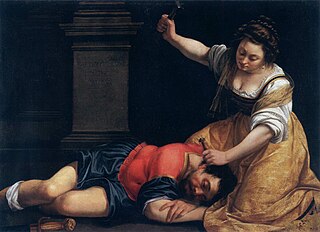
Jael and Sisera is a painting by the Italian Baroque artist Artemisia Gentileschi, executed around 1620.
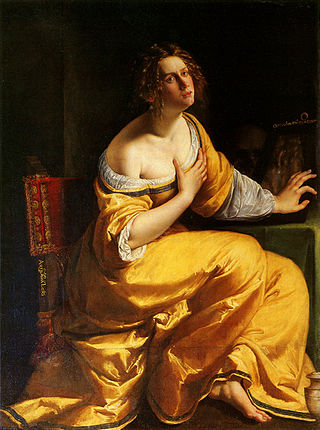
Penitent Magdalene is a 1616–1618 painting by the Italian baroque artist Artemisia Gentileschi. This painting hangs in the Pitti Palace in Florence. The subject is the biblical figure Mary Magdalene, but the painting references another biblical woman, Mary, the sister of Lazarus. This painting was likely painted during Gentileschi's Florentine period.

Judith Slaying Holofernes c. 1620, now at the Uffizi Gallery in Florence, is the renowned painting by Baroque artist Artemisia Gentileschi depicting the assassination of Holofernes from the apocryphal Book of Judith. When compared to her earlier interpretation from Naples c. 1612, there are subtle but marked improvements to the composition and detailed elements of the work. These differences display the skill of a cultivated Baroque painter, with the adept use of chiaroscuro and realism to express the violent tension between Judith, Abra, and the dying Holofernes.

Cleopatra is a 1611-1612 oil on canvas painting of Cleopatra by Artemisia Gentileschi, now in the private Etro collection in Milan.

Tarquin and Lucretia is a 1620–1650 oil on canvas painting by Artemisia Gentileschi. It hangs in the Great Hall of the Neues Palais in Potsdam. It is one of three paintings that Gentileschi painted of Lucretia, the wife of Roman consul and general Tarquinus, at the moment of her suicide. The other two versions are in a private collection in Milan and The Getty Museum in Los Angeles.
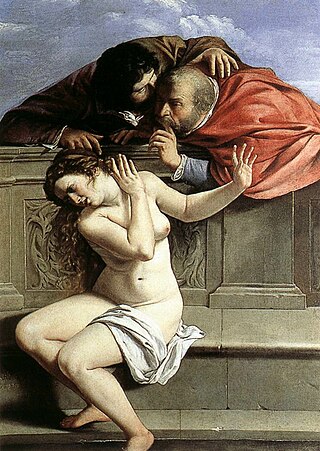
Susanna and the Elders is an Old Testament story of a woman falsely accused of adultery after she refuses two men who, after discovering one another in the act of spying on her while she bathes, conspire to blackmail her for sex. Depictions of the story date back to the late 3rd/early 4th centuries and are still being created.
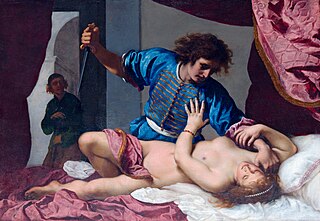
The Rape of Lucretia is any of several paintings, variations of the same subject, which are usually attributed to either Felice Ficherelli or Guido Cagnacci and dated to the late 1630s or about 1640.



















